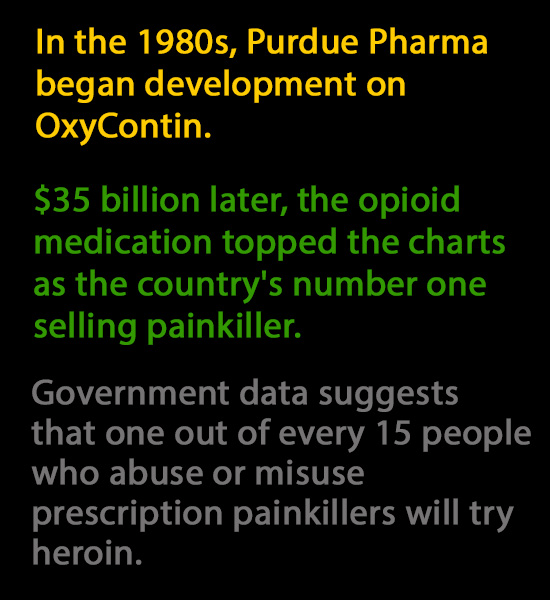As the patent on MS Contin, a morphine pill for cancer patients, moved toward expiration in the late 1980s, its maker, Purdue Pharma, began development on OxyContin. Fast forward a few years and $35 billion later and the opioid medication topped the charts as the country’s number one selling painkiller. The company had a problem, though.

According to the L.A. Times investigation published in May 2016, Purdue Pharma knew of “excruciating symptoms of withdrawal, including an intense craving for the drug” even before its release on the market.
Most experts agree that OxyContin’s release kick-started a rampant cycle of prescription painkiller misuse, and as a result, heroin abuse in the United States. The National Institute on Drug Abuse (NIH) reports that since 1999, unintentional overdose deaths due to prescription painkillers have more than quadrupled, totaling almost 200,000.
Government data also suggests that one out of every 15 people who abuse or misuse prescription painkillers will try heroin.
Reporters for The Times utilized documents from government inquiries into Purdue’s practices, as well as internal company documents, some of which were previously sealed by courts. These included sales reports, memos, emails and sworn testimony by sales reps and executives.
Their investigation amassed evidence of misleading and dubious strategies to gain approval from the Food and Drug Administration (FDA) going back nearly 30 years.
What Did the L.A. Times Investigation Reveal About Purdue Pharma’s Oxycontin?
Some of the more egregious revelations, uncovered by The Times, include:
- Purdue’s insistence that OxyContin be marketed as a 12 hour pain reliever despite overwhelming evidence from its own clinical studies that the medication lasted substantially less than 12 hours in most patients
- Ignoring complaints by sales reps, doctors and independent research about the 12 hour window in an effort “to protect its revenue”
- Telling doctors to prescribe higher doses of the addictive opioid painkiller and “not more frequent ones, when the patient complains that OxyContin doesn’t last 12 hours”
- Marketing OxyContin for use in everyday injuries or common complaints, such as knee pain, sprained ankles or back aches, under the twice a day (12 hour) dosing
- Incentivizing sales reps to sell the painkiller in high doses, which increased the company’s profits
If used as directed, just twice a day, Theodore J. Cicero, told The Times, OxyContin might be “the perfect recipe for addiction.” A neuropharmacologist at Washington University’s School of Medicine in St. Louis, Cicero said that when the drug wears off before the 12-hour window is over, patients could experience “the beginning stages of acute withdrawal. That becomes a very powerful motivator for people to take more drugs.”
Executives at Purdue, in 2007, pled guilty for downplaying OxyContin’s risk of addiction. They were convicted of fraud and ordered to pay $635 million. During the investigation by the U.S. Justice Department and the subsequent hearings, though, evidence that the drug’s advertised 12-hour pain relief was untrue never came to light.
For its part, Purdue issued a statement that “rejects the claims made by The Los Angeles Times (LAT) in ‘OxyContin’s 12-Hour Problem.'”
In their response, The Times said, “Our editors see nothing in Purdue’s statement that casts doubt on our reporting or our findings.”
Meanwhile, rates of opioid addiction continue to skyrocket. The Substance Abuse and Mental Health Services Administration writes that 4.3 million people engaged in the non-medical use of prescription painkillers last month and an estimated 435,000 people used heroin in the same period.
Even more sobering, the Centers for Disease Control and Prevention say that in the United States, an average of 78 people die each day from an opioid overdose.
As for OxyContin, The Times reports that in 2014 doctors wrote 5.4 million prescriptions for the medication. A Purdue spokesman confirmed for the paper that “80% were for 12-hour dosing.”





